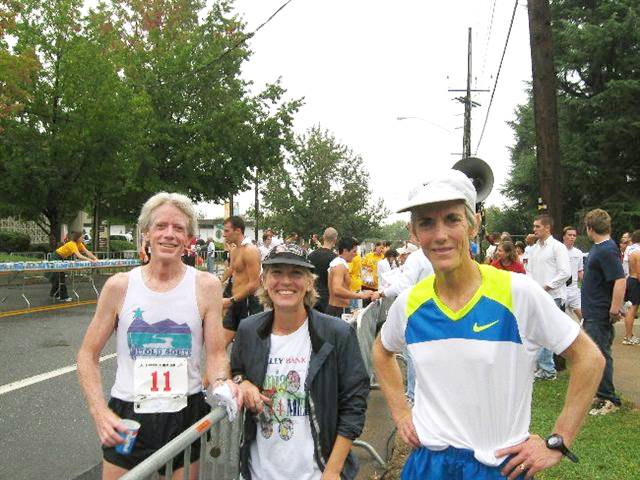
One hot July day back in 1983, 112 women and girls leaned forward, anticipating the starter’s gun, poised to launch themselves with arms flailing and feet pounding on the sticky asphalt. It was 3.1 miles down and back on Wiley Drive for the first all-women’s non-scholastic race in the Roanoke Valley, the inaugural Women’s Distance Festival.
Young husbands and boyfriends (some serving as stand-in mommies) cheered from the park as the runners passed by while toddlers frolicked and babies wailed. Star City Strider volunteers called out split times and watched entrants for signs of heat distress. Only 17:44 minutes later, winner Beth Dillinger (now Howell) of Blacksburg crossed the finish line. Roanoker Liza Field, then 21, followed, coming in at 18:47, with Laura Shea coming in third at 20:28.
Less than thirty-five minutes after the race began, history had been made in the Star City, although the women standing around laughing and talking weren’t overly concerned about history. They were glad for a chance to compete as athletes, glad for the chance to do something they loved, glad to be with their peers, mothers and sisters, as runners.
In 1983, an Olympic Marathon for women was still a dream which finally came true a year later in Los Angeles. No female at the ‘83 Women’s Distance Festival had ever before witnessed a woman run further than 1,500m (less than a mile) in any Olympic event because women were considered too fragile, not interested in distance running, and besides, some argued, long distances were dangerous to a woman’s health. Time has proven all those assertions incorrect.
Nationally, the Women’s Distance Festival (WDF) races began in 1980 to demonstrate women’s widespread interest in the sport and to bring attention to “the lack of distance running events in the Olympic Games for women” according to the organizers, the Road Runners Club of America (RRCA). The response was enormous as women all over the country showed up to walk and run in numbers unheard of before. Roanoke joined the chorus in 1983.
The WDF participants were pioneers of sorts, women and girls who became runners during the late 1970’s and early 80’s, determined to buck tradition so they could compete and participate in road racing, not merely watch and cheer. Dr. Sandy Andrew, a Strider member and local dentist, was among the entrants in that first race.
Sandy, who later served as race director for Roanoke’s WDF from 1987-1998, says the women’s race had a “grass roots” feel in the early years. Success was measured not by how much profit it generated, but by how many women and girls it helped get started as runners and by the friendships formed.
Liza Field’s mother, Betty, ran an age-group winning time of 22:09 in 1983. Betty Field was one of the first Roanoke females to train away from a track before the late 70’s running boom. She purchased a pair of flat track shoes in 1970 at age 37, marked out a loop in her neighborhood, and ran most days before dawn.
Candice Michalik of Lynchburg traveled to Roanoke in 1983 because “it was exciting to run in a woman’s-only race.”
Michalik finished 8th at the inaugural WDF, but her favorite memory came at the 1989 women’s race when her daughter Ellen declared that she wanted to be a runner “ just like you” so they could run as a team.
Peggy Bryant turned 50 in 1983, and ran the WDF near the back of the pack. Some of her friends and family thought she was “crazy” for not acting her age, only making Bryant more determined to keep running. Her proudest accomplishment as a runner was finishing last at the now defunct Roanoke Marathon in just under six hours, refusing to quit though running alone.
Beth Howell still holds the record in this event’s history, one might assume she had a glorious scholastic running career prior to 1983, when she was 28. She once broke 17 minutes at a 5K, ran a sub-37 minute 10K, and qualified for the 1984 USOC. Women’s Olympic Marathon Trials, where she ran a 2:47:45 over 26.2 miles.
But, Howell never ran in high school because there was no track or cross country program for girls. In college, she began running “one mile most days for fun”. It was only after moving to Blacksburg in 1979 that Howell “began training with the guys.” When she started winning local road races, finishing far ahead of most male entrants, Howell realized she “might have some talent.”
The WDF race, now the Star City Women’s 5K, is filled with story after story of women who came to running without benefit of coaching, the support of teammates, or the opportunity to compete scholastically. Because they toed the line and ran, the girls and women who raced that July day in 1983 helped blaze a path to a Roanoke Valley where little girls can not only dream dreams of athletic glory, but also have the occasion to pursue them.
The 26th annual Star City Women’s 5K will be held Saturday, October 3, at 9:00 am. Visits www.starcitystriders.com for more information, or contact Amy Rockhill, Race Director, at [email protected] with any questions.
By Rick Watkins info@newsroanoke
